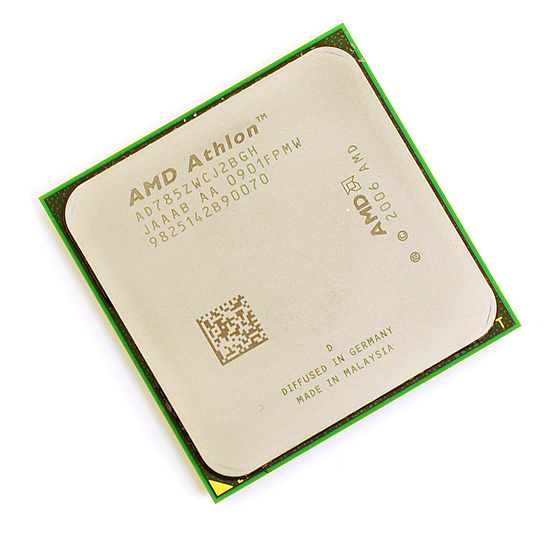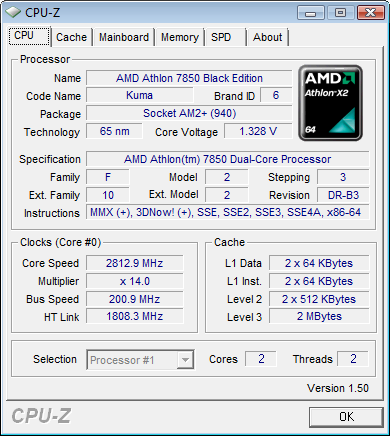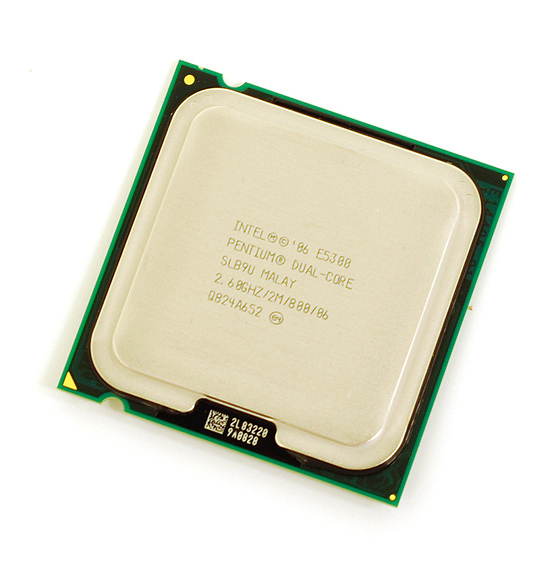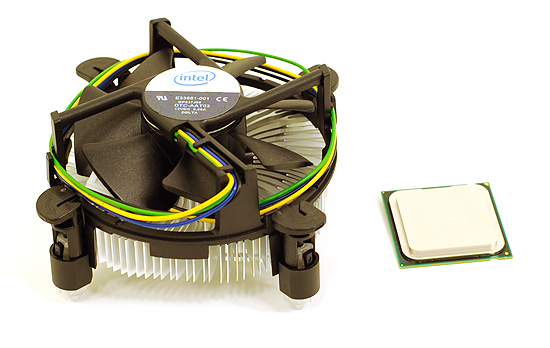AMD Athlon X2 7850 vs. Intel Pentium E5300: Choosing the Best $70 CPU
by Anand Lal Shimpi on April 28, 2009 11:00 AM EST- Posted in
- CPUs
AMD celebrates its 40 year anniversary next month, and the Athlon brand turns ten shortly thereafter. What better way to celebrate than by releasing a rebadged 65nm Phenom processor with two cores disabled at $69? Er, or, I guess they could’ve sent a cake.
It’s called the Athlon X2 7850 and it actually has very little in common with the old Athlon 64 X2s. As I mentioned, these are rebadged 65nm Phenom processors with two cores disabled. The table below should give you a good comparison between the die size and transistor count of the original Phenom compared to the new Athlon X2:
| Processor | Manufacturing Process | Die Size | Transistor Count |
| AMD Phenom X4 9950 | 65nm | 285 mm2 | 450M |
| AMD Athlon X2 7850 | 65nm | 285 mm2 | 450M |
There’s no surprise that the specs are identical, because the processors are identical. AMD simply disables two of the Phenom’s four cores in production before shipping the parts.
In its heyday the original Phenom never broke 2.6GHz, but with a fully mature 65nm process and only two functional cores AMD is able to clock these parts higher. The first dual-core Phenom derivative was the Athlon X2 7750 and it ran at 2.7GHz. In AMD’s tradition of introducing far too many CPUs, today AMD expands the list with a 2.8GHz Athlon X2 7850.

Once again this is the original Phenom processor; none of the advancements found in the Phenom II are included - it also means that the architecture doesn’t make quite as much sense.

It's a Socket-AM2+ Processor
The original Phenom architecture was designed to be used for quad-core processor designs, hence the use of a large shared L3 cache alongside private L2 caches. With only two cores, many of the benefits of this architecture are lost. Intel discovered that the ideal dual-core architecture featured two levels of cache with a large, fast, L2 shared by both cores. AMD and Intel came to the conclusion that the ideal quad-core architecture had private L2 caches (one per core) with a large, shared L3 cache. The Athlon X2 7850 takes the cache hierarchy of the ideal quad-core design and uses it on a dual-core processor.

To make matters worse, it does so with an incredibly small L3. Intel found that on its Nehalem processor each core needed a minimum of 2MB of L3 cache for optimal performance. With Phenom II AMD settled on 1.5MB L3 per core. The original Phenom gave each core 512KB of L3, or in the case of a dual-core derivative 1MB of L3 cache. Again, not ideal.
But it only costs $69.
And things should be easier for AMD at the $69 price point - there’s no Nehalem to worry about down here, only cache starved Core 2 processors. Priced at $74 we have Intel’s Pentium E5300.
It’s a Difference of Cache
The Athlon X2 7850 is based on the original 65nm Phenom core, but with only two cores enabled. That means we’ve got a 64KB L1 data cache, 64KB L1 instruction cache and a 512KB L2 cache per core. There’s also this catch-all 2MB L3 cache, but it’s unfortunately very high latency by comparison.

The Pentium E5300
The Pentium E5300 is a trimmed down version of Intel’s 45nm Wolfdale core. Each core has a 32KB L1 data cache and a 32KB L1 instruction cache, smaller than the Athlon X2. The L2 cache is shared between the cores and is 2MB in size. It takes just as long to access data from Intel’s 2MB shared L2 as it does to get data from AMD’s 512KB L2. Intel does not have an L3 cache but it also doesn’t have an on-die memory controller, so final accesses to memory are a lot slower on Intel’s hardware.

It's all LGA-775
AMD has more cache but it’s slower than Intel’s, once you get out to main memory the Athlon X2 can get to data quicker but the E5300 has the benefit of more advanced prefetchers.

The E5300 is a 45nm chip meaning it can be cooled by Intel's low profile boxed heatsink
Intel’s architecture also has a wider 4-issue front end compared to the Athlon X2. The execution advantage should go to Intel. With a higher IPC, Intel doesn’t need to run at the same clock speeds to outperform AMD. However with an on-die memory controller, the Athlon X2 could pull ahead in applications that don’t fit nicely within the E5300’s L2 cache.
While the Phenom II has been enjoying clear victories over Intel’s equivalently priced processors in the higher end space, it looks like crowning a winner at $70 will take a little more work.










55 Comments
View All Comments
JimmiG - Tuesday, April 28, 2009 - link
Interesting to see the X4 9850 at 2.5GHz beating the higher clocked Phenom-derived Athlon X2 in many of the game tests. If multithreaded performance of games continue to improve, I think a Quad or Triple core CPU would be more future proof?The Phenom II X3 is a very nice AMD gaming CPU at this time and a tempting "sidegrade" even though I've already got a first-generation Phenom X4.
Davelo - Tuesday, April 28, 2009 - link
and then totally ignores it's original premise. I'm no fanboy but I find it very hard to miss the fact that the Intel solution costs almost $150 more when you factor in the added cost of the motherboard.Anand Lal Shimpi - Tuesday, April 28, 2009 - link
I used the X48 simply to allow for direct comparisons to all of the other CPU test data in Bench - www.anandtech.com/bench. The X48 performs similarly to the P45 and the P35 (and many other similar chipsets if you're not overclocking), so the comparison is still valid.Take care,
Anand
lopri - Tuesday, April 28, 2009 - link
What about power consumption comparison? Are you penalizing E5300 with X48 there? That'd be incredibly stupid and unfair to E5300.And this paragraph makes no sense to me. (literally)
Interesting review, nevertheless.
TA152H - Tuesday, April 28, 2009 - link
What he was trying to say was, the ideal cache set up for a quad-core is different from a dual-core. The quad-core is best with a relatively small and fast L2 cache, and a significantly larger L3 cache. The dual core is best with a relatively large L2 cache, and no L3 cache. Because AMD's processor is a quad-core stripped down to a dual-core, it has the cache hierarchy of the quad-core, even though it's a dual core now. So, it's not the ideal cache setup.edogawaconan - Tuesday, April 28, 2009 - link
Also worth noting that not all lower-end Intel processor includes VT-x which (arguably?) helps accelerating speed for tasks related to virtualization.stmok - Wednesday, April 29, 2009 - link
Actually, Intel's VT or AMD-V doesn't do much for performance. (You'll see this with VirtualBox. What it does provide is a more stable development approach to virtualization for the software programmer.)The one area where you will see a performance increase is with "nested paging". (A 2nd generation virtualisation feature).
In that case, the Phenom-based Athlon X2 clearly wins. NONE of the Core 2 series have nested paging, only Core i7 series...And this Core 2 doesn't have Intel VT either! Nested paging was introduced in all K10 based AMD CPUs. (Its also carried onto K10.5 or Phenom II processors).
nvmarino - Tuesday, April 28, 2009 - link
Considering the low price and low FSB/high multiplier of the E5300 makes it a perfect candidate for overclocking I'm surprised you guys didn't do some OC tests. Would be nice to see the impact of smaller cache at higher clocks.My e5300 does 3.7Ghz easily with a PoS air cooler.
aeternitas - Tuesday, April 28, 2009 - link
I think this review needs to be augmented with OC capabilities and the tests redone with them.Its highly unrealistic to test these at stock. The mass majority of people that would care about this review at this price are getting these cpus because of the insane bargain when OCed.
To not test that is really unrealistic. It makes this whole article much less usefull than it could have been.
nubie - Tuesday, April 28, 2009 - link
I went for the e5200 for $59 on ebay. Same chip but with a 12.5 multi instead of 13.I plan on running it well north of 3 ghz on a day to day basis, either 1066 or 1333 FSB. Even 1066 will get you a solid 3.4ghz, and it should be able to reach that easily on any motherboard.
You completely forgot to mention that this is the only 800mhz FSB line on a 45nm process, and thus can be overclocked in any motherboard, including $45 ones with a simple strap on the FSB pads.
I think that Intel is the clear winner, hands down, if you are an enthusiast with very little money who is not opposed to overclocking.